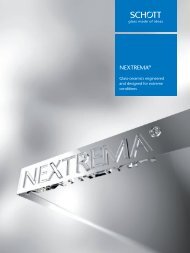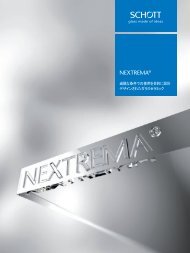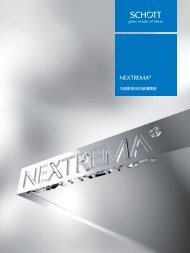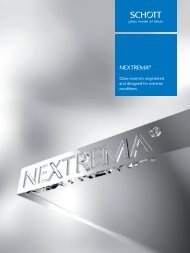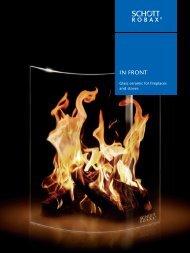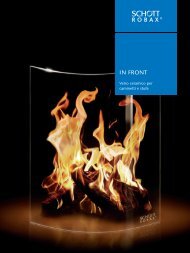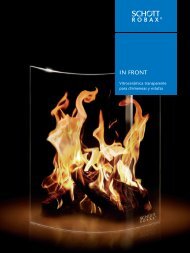SCHOTT Technical Glasses
Apart from its application in optics, glass as a technical material has exerted a formative influence on the development of important technological fields such as chemistry, pharmaceutics, automotive, optics, optoelectronics and information technology. SCHOTT Technical Glasses offers pertinent information in concise form. It contains general information for the determination and evaluation of important glass properties and also informs about specific chemical and physical characteristics and possible applications of the commercial technical glasses produced by SCHOTT. With this brochure, we hope to assist scientists, engineers, and designers in making the appropriate choice and make optimum use of SCHOTT products.
Apart from its application in optics, glass as a technical material has exerted a formative influence on the development of important technological fields such as chemistry, pharmaceutics, automotive, optics, optoelectronics and information technology. SCHOTT Technical Glasses offers pertinent information in concise form. It contains general information for the determination and evaluation of important glass properties and also informs about specific chemical and physical characteristics and possible applications of the commercial technical glasses produced by SCHOTT. With this brochure, we hope to assist scientists, engineers, and designers in making the appropriate choice and make optimum use of SCHOTT products.
Create successful ePaper yourself
Turn your PDF publications into a flip-book with our unique Google optimized e-Paper software.
26<br />
Optical glass<br />
The term “optical glass” is used in distinction to “technical<br />
glass” for a specific group of glasses mainly for optical<br />
applications like imaging in the UV, visible, and infrared<br />
wavelength range. These applications require a broad set<br />
of glasses with high transmission and well defined refractive<br />
index and specific dispersion properties (described by<br />
Abbe-numbers). Combinations of these glasses allow for<br />
the construction of high-performance optical systems.<br />
Up to 17 or more different raw materials with the lowest<br />
level of impurities to avoid absorption by coloring elements<br />
are used to achieve the desired specifications. Each optical<br />
glass is described (beside others) by its coordinates in the<br />
so-called “Abbe-Diagram” (see Figure 23).<br />
Optical filter glass<br />
Optical filter glass is known for its selective absorption in<br />
certain wavelength ranges. The absorption within the glasses<br />
is caused either by ions of heavy metals or of rare earths or<br />
it is caused by nano crystals within the glass matrix. By combining<br />
different coloring agents a wide range of different<br />
filter functions (neutral density filters, longpass filters, short<br />
pass filters and bandpass filters) can be obtained. Figure 25<br />
depicts special UV bandpass filters that have a region of<br />
high internal transmittance in the UV and high absorption<br />
for visible light.<br />
As an alternative to bulk filter glasses, coated interference<br />
filters are used. Here a transparent glass substrate is coated<br />
with a set of thin transparent layers of e.g. oxidic materials<br />
with different refractive indices. The spectral properties of<br />
these filters are defined by interference effects.<br />
Optical filter glass and inteference filters are optimized for<br />
industrial applications, thus the main focus is the reproducibility<br />
of spectral transmittance. However, these glasses<br />
appear to be colored if their filter effect lies within the visible<br />
light spectrum.<br />
Chalcogenide glass<br />
In most known glass types, oxides of e.g. silicon, phosphorous,<br />
lanthanum and borate are building the glass forming<br />
network. Though some oxidic glass types with special compositions<br />
melted under very dry conditions show transmittance<br />
until 4 – 5 microns, the absorption of the cation-O-bond<br />
in the network sets a limit to the (mid – far) infrared (IR)<br />
transmission of these glasses. The main characteristic of<br />
chalcogenide glasses is the complete replacement of the<br />
element oxygen by other elements of the chalcogenide<br />
group like sulfur, selenium or tellurium to extend transmittance<br />
further into the mid to far IR. For instance, <strong>SCHOTT</strong> IR<br />
chalcogenide glasses (IRG) exhibit high transmission from<br />
the visible range to beyond 12 µm into the far infrared (see.<br />
Figure 24).<br />
2.05<br />
95<br />
ν d<br />
90<br />
85 80 75 70 65 60 55 50 45 40 35 30 25 20<br />
35<br />
2.05<br />
Transmission of IRG 22–26<br />
80<br />
Thickness 10.0 mm (Typical Values)<br />
2.00<br />
1.95<br />
1.90<br />
Abbe-Diagram n d –ν d<br />
Description of Symbols<br />
Lead and arsenic free N- or P-glass<br />
Classical crown and flint glass<br />
Glass available as N-glass or classical flint glass<br />
46A<br />
46B<br />
68<br />
66<br />
67<br />
2.00 n d<br />
1.95<br />
1.90<br />
70<br />
60<br />
n d<br />
85 80 75 70 65 60 55 50 45 40 35 30 25 20<br />
1.85<br />
Glass suitable for precision molding<br />
HT – High transmittance glass<br />
HTultra – Ultra high transmittance glass<br />
31A<br />
LASF<br />
9<br />
57<br />
1.85<br />
50<br />
1.80<br />
* Available in step 0.5<br />
21<br />
44*<br />
33<br />
41<br />
51 50<br />
47 43<br />
40<br />
45<br />
56A<br />
6<br />
*<br />
SF<br />
11<br />
1.80<br />
40<br />
1.75<br />
1.70<br />
1.65<br />
1.60<br />
1.55<br />
1.50<br />
1.45<br />
95<br />
58<br />
90<br />
51A*<br />
52 A<br />
FK<br />
51*<br />
PK<br />
PSK<br />
5*<br />
10<br />
53A*<br />
3<br />
7*<br />
BK<br />
LAK<br />
16<br />
60<br />
4<br />
14<br />
5 57SK<br />
11<br />
21<br />
58A<br />
7<br />
ZK7<br />
5<br />
2<br />
7<br />
57Q1<br />
1<br />
4<br />
BAK<br />
K<br />
22<br />
10<br />
34<br />
14<br />
9*<br />
12<br />
2*<br />
8<br />
4<br />
5<br />
33A<br />
2<br />
35<br />
5<br />
SSK<br />
BALF<br />
KZFS2*<br />
KF<br />
9<br />
33B<br />
10<br />
8<br />
34<br />
35<br />
10<br />
LLF<br />
37<br />
2<br />
51<br />
BAF<br />
KZFS4*<br />
52<br />
1<br />
4<br />
LF<br />
LAF<br />
64<br />
BASF<br />
2<br />
KZFS5* 2*<br />
KZFS11*<br />
5<br />
5<br />
F<br />
2<br />
7<br />
KZFS 8*<br />
5*<br />
8<br />
15<br />
10<br />
69<br />
1<br />
4<br />
14<br />
1.75<br />
1.70<br />
1.65<br />
1.60<br />
1.55<br />
1.50<br />
1.45<br />
March 2015<br />
Transmission in % ––><br />
30<br />
20<br />
10<br />
0<br />
0 2000 4000 6000 8000 10000 12000 14000 16000 18000<br />
Wavelength in nm ––><br />
IRG 22 IRG 23 IRG 24 IRG 25 IRG 26<br />
ν d<br />
Fig. 23. <strong>SCHOTT</strong> Advanced Optics Abbe-Diagram that gives an overview<br />
of <strong>SCHOTT</strong>’s optical glass types<br />
Fig. 24. Transmission of IRG 22 – 26






